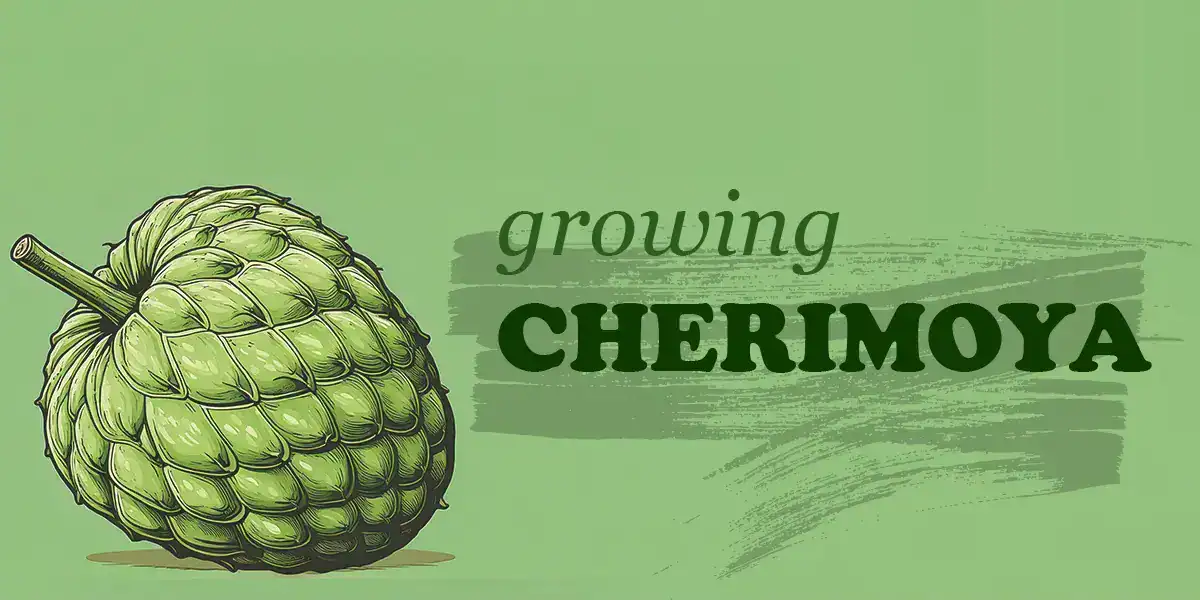Mark Twain called it “the most delicious fruit known to men.”
He was referring to the cherimoya, a living fossil from the highland valleys of Ecuador, Peru, and Bolivia.
Ripe cherimoya spoils quickly and is hard to ship, so it’s considered a luxury fruit outside its growing regions.
Luckily for California fruit lovers, the cherimoya tree does well in many zones throughout the state, and if the tree is in your yard, the fruit won’t travel far enough to spoil.
Do your relatives in Ohio have a hankering for cherimoya? They can always visit during harvest season.
Basics of the Cherimoya
A cherimoya tree grows 20–30 feet high and produces large, bumpy fruit weighing up to 5 pounds each.
The fruit has thick, creamy white flesh and green, scaly skin. According to some, its flavor is an unbeatable combination of pineapple, banana, papaya, and strawberry.
When ripe, a cherimoya’s skin changes from green to brown, but the flesh should still be firm. Overripe cherimoyas will have soft spots or bruises on their skin.
January to April is the time to harvest cherimoya in California.
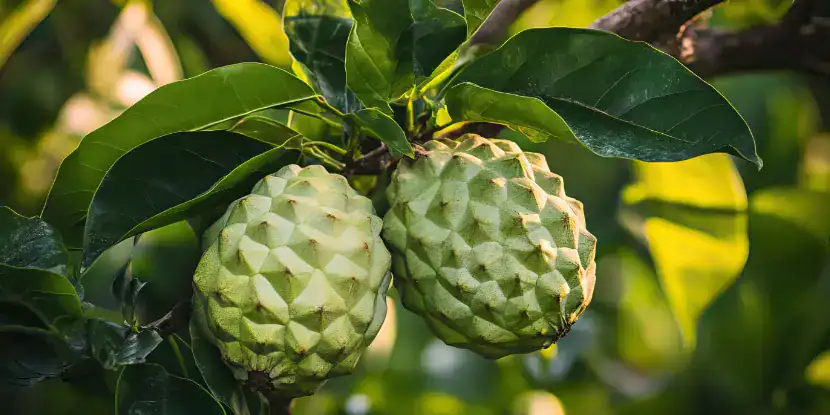
Cherimoya fruit ripening on the tree.
Best Varieties for Southern California
Not all cherimoya varieties love SoCal’s Mediterranean climate. The ones that do include:
- ‘Fino de Jete’ – A widely grown variety with smooth skin and rich flavor.
- ‘Booth’ – Hardy and perfect for home gardens, producing heavy yields with reliable pollination.
- ‘Dr. White’ – Produces large fruits with sweet, custard-like flesh.
- ‘El Bumpo’ – Offers excellent flavor with a slightly bumpy exterior.
- ‘Honeyheart’ – A high-yielding variety with smooth skin and intensely sweet fruit.
Optimal Growing Conditions
Light
- Cherimoya trees need full sun.
- Pick a location with at least 6–8 hours of sunlight daily.
- Consider partial afternoon shade for inland areas with intense heat to protect the tree.
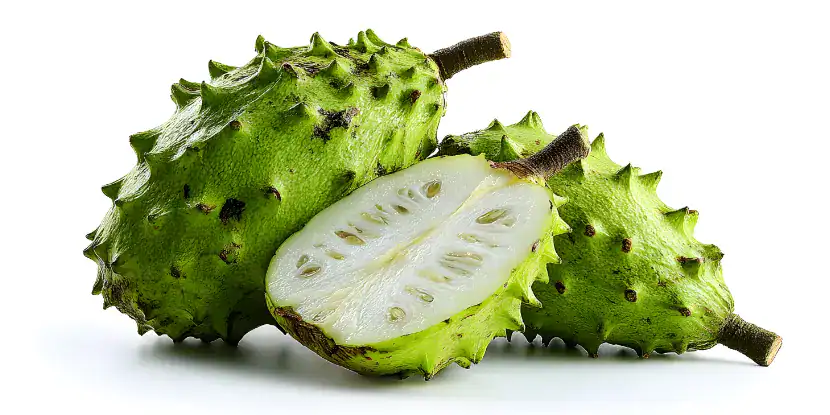
These prickly cherimoyas taste every bit as sweet as scaly varieties.
Temperature
- Ideal temperatures for cherimoya range between 60°F and 85°F.
- Mature trees can handle brief cold snaps, but prolonged temperatures below 30°F will cause damage.
- Coastal and inland Southern California climates offer a sweet spot for cherimoya growth.
Soil
- Cherimoya prefers well-draining soil with a pH between 6.5 and 7.5.
- Avoid heavy, clay-based soil that can waterlog roots.
- Amending soil with organic compost can improve aeration and fertility.
Starting from Seed
- Scoop seeds from a ripe cherimoya fruit and wash off any pulp.
- Dry the seeds for 2–3 days.
- Scarify the seed coating by lightly sanding or nicking it with a knife — this speeds up germination.
- Plant the seeds in a pot filled with well-draining potting mix, about 1/2 inch deep.
- Water generously, then keep the soil moist but not soggy.
- Place the pot in a warm location. Germination takes 3–6 weeks.
Cherimoya trees grown from seed bear fruit in 4–7 years.
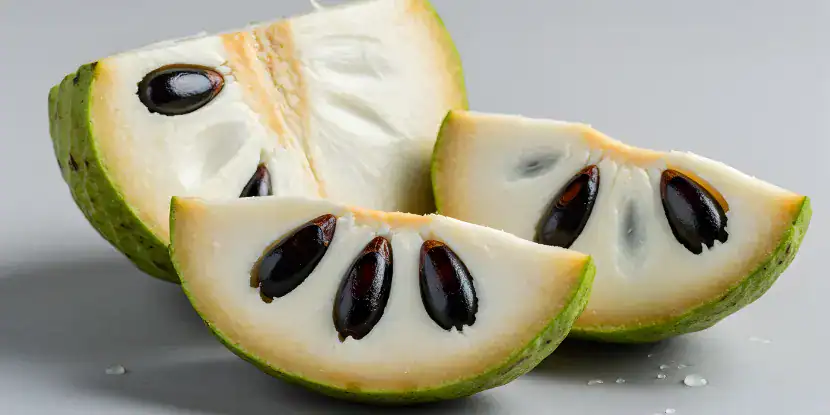
Cherimoya has creamy white flesh, green, scaly skin, and large seeds that you can grow into trees!
Transplanting Cherimoya
Transplant your seedling outdoors when it’s 6–12 inches tall.
- Choose a location with full sun and well-draining soil.
- Dig a hole twice as wide and slightly deeper than the root ball.
- Place the plant in the hole, ensuring the soil line matches its current level in the pot.
- Fill the surrounding area with soil and water deeply.
- Add a layer of mulch to retain soil moisture.
Cherimoya Tree Care
Water
- Cherimoya trees need regular watering during the growing season, especially during summer.
- Water them deeply once or twice a week, allowing the soil to dry slightly between sessions.
- Reduce watering during dormant winter months to avoid root rot.
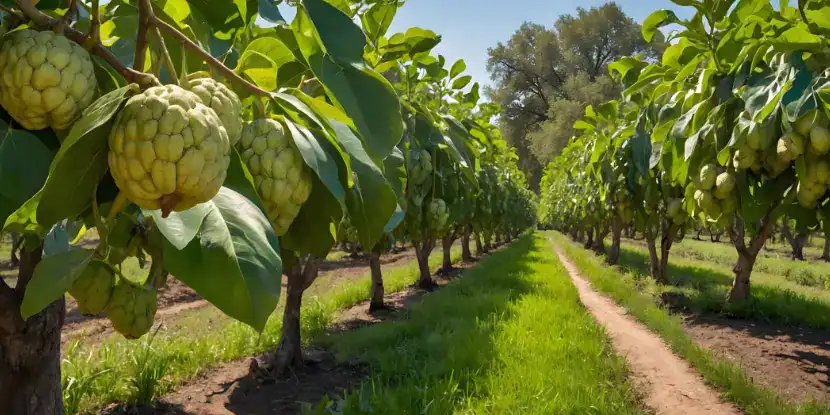
Cherimoya trees laden with fruit.
Fertilizer
- Feed your cherimoya tree with a balanced nitrogen, phosphorus, and potassium fertilizer.
- Apply fertilizer every 6–8 weeks during the growing season (spring through summer).
- Organic options like compost or aged manure also work well.
Pests & Diseases
Watch for:
- Aphids – Control with insecticidal soap or neem oil.
- Fruit borers – Bag developing fruits to prevent infestation.
- Root rot – Avoid overwatering, and ensure proper drainage.
Harvesting Cherimoya
Cherimoya fruits are ready for harvest when they feel firm but begin to lose their bright green color. To check for ripeness:
- Gently press the fruit. Ripe cherimoya should yield slightly, like an avocado.
- Cut the fruit from the tree, leaving a small stem attached.
Once harvested, ripen the fruits at room temperature until slightly soft, then store them in the refrigerator and eat within a few days.
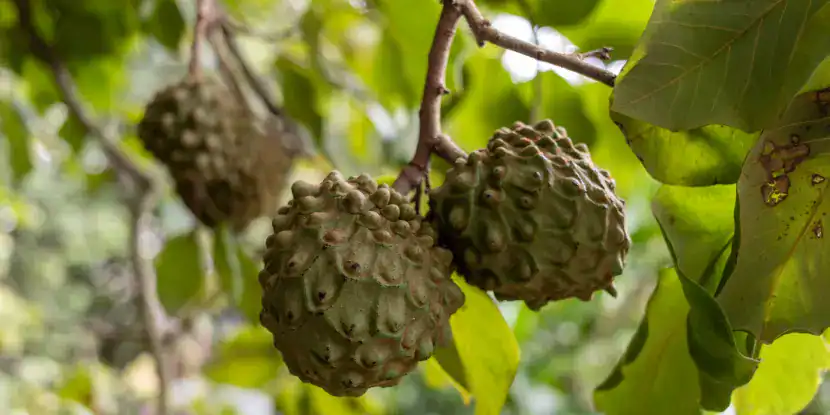
Cherimoya fruits are ready for harvest when they begin to lose their bright green color.
Cherimoya Fruit Uses
Popular uses include:
- Eating fresh with a spoon — no preparation required!
- Adding diced cherimoya to smoothies or fruit salads.
- Creating milkshakes, ice creams, or sorbets.
- Using it as a topping for yogurt, granola, or pancakes.
- Baking it into pies or tarts for a tropical twist.
FAQs: Growing Cherimoya
Q: How long does it take for a cherimoya tree to bear fruit?
Trees grown from seed take 4–7 years; grafted trees typically produce fruit in 2–3 years.
Q: Do cherimoya trees need hand pollination?
Hand pollination during spring often increases fruit set, as natural pollinators like beetles may be limited.
Q: What’s the best time to plant cherimoya?
Early spring planting allows the tree to establish roots before summer heat.
Q: Can cherimoya trees grow in pots?
Yes, but ensure the pot is large enough — at least 15–20 gallons — and has excellent drainage.
Q: When is cherimoya’s growing season?
Cherimoya trees grow from spring to summer and go dormant in the winter.
Q: How much space should I leave between cherimoya trees?
Space trees about 20 feet apart. They’ll develop wide, spreading canopies.
Q: What are common signs of overwatering?
Yellowing leaves, soggy soil, and root rot often indicate too much water.
Q: How do I store cherimoya fruit?
Ripen at room temperature, then refrigerate. Don’t wait too long before eating it!

